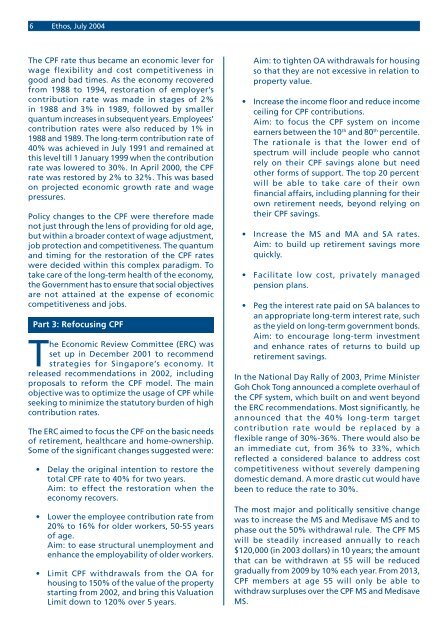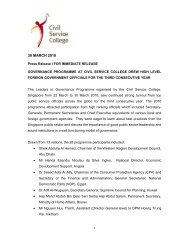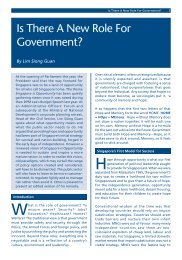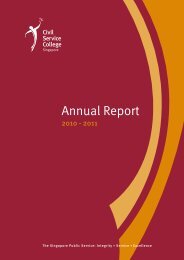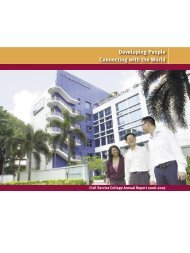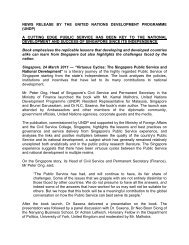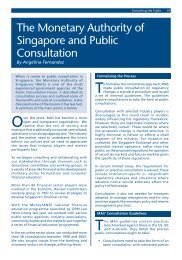The Central Provident Fund: More Than Retirement - Civil Service ...
The Central Provident Fund: More Than Retirement - Civil Service ...
The Central Provident Fund: More Than Retirement - Civil Service ...
You also want an ePaper? Increase the reach of your titles
YUMPU automatically turns print PDFs into web optimized ePapers that Google loves.
6 Ethos, July 2004<strong>The</strong> CPF rate thus became an economic lever forwage flexibility and cost competitiveness ingood and bad times. As the economy recoveredfrom 1988 to 1994, restoration of employer’scontribution rate was made in stages of 2%in 1988 and 3% in 1989, followed by smallerquantum increases in subsequent years. Employees’contribution rates were also reduced by 1% in1988 and 1989. <strong>The</strong> long-term contribution rate of40% was achieved in July 1991 and remained atthis level till 1 January 1999 when the contributionrate was lowered to 30%. In April 2000, the CPFrate was restored by 2% to 32%. This was basedon projected economic growth rate and wagepressures.Policy changes to the CPF were therefore madenot just through the lens of providing for old age,but within a broader context of wage adjustment,job protection and competitiveness. <strong>The</strong> quantumand timing for the restoration of the CPF rateswere decided within this complex paradigm. Totake care of the long-term health of the economy,the Government has to ensure that social objectivesare not attained at the expense of economiccompetitiveness and jobs.Part 3: Refocusing CPF<strong>The</strong> Economic Review Committee (ERC) wasset up in December 2001 to recommendstrategies for Singapore’s economy. Itreleased recommendations in 2002, includingproposals to reform the CPF model. <strong>The</strong> mainobjective was to optimize the usage of CPF whileseeking to minimize the statutory burden of highcontribution rates.<strong>The</strong> ERC aimed to focus the CPF on the basic needsof retirement, healthcare and home-ownership.Some of the significant changes suggested were:• Delay the original intention to restore thetotal CPF rate to 40% for two years.Aim: to effect the restoration when theeconomy recovers.• Lower the employee contribution rate from20% to 16% for older workers, 50-55 yearsof age.Aim: to ease structural unemployment andenhance the employability of older workers.• Limit CPF withdrawals from the OA forhousing to 150% of the value of the propertystarting from 2002, and bring this ValuationLimit down to 120% over 5 years.Aim: to tighten OA withdrawals for housingso that they are not excessive in relation toproperty value.• Increase the income floor and reduce incomeceiling for CPF contributions.Aim: to focus the CPF system on incomeearners between the 10 th and 80 th percentile.<strong>The</strong> rationale is that the lower end ofspectrum will include people who cannotrely on their CPF savings alone but needother forms of support. <strong>The</strong> top 20 percentwill be able to take care of their ownfinancial affairs, including planning for theirown retirement needs, beyond relying ontheir CPF savings.• Increase the MS and MA and SA rates.Aim: to build up retirement savings morequickly.• Facilitate low cost, privately managedpension plans.• Peg the interest rate paid on SA balances toan appropriate long-term interest rate, suchas the yield on long-term government bonds.Aim: to encourage long-term investmentand enhance rates of returns to build upretirement savings.In the National Day Rally of 2003, Prime MinisterGoh Chok Tong announced a complete overhaul ofthe CPF system, which built on and went beyondthe ERC recommendations. Most significantly, heannounced that the 40% long-term targetcontribution rate would be replaced by aflexible range of 30%-36%. <strong>The</strong>re would also bean immediate cut, from 36% to 33%, whichreflected a considered balance to address costcompetitiveness without severely dampeningdomestic demand. A more drastic cut would havebeen to reduce the rate to 30%.<strong>The</strong> most major and politically sensitive changewas to increase the MS and Medisave MS and tophase out the 50% withdrawal rule. <strong>The</strong> CPF MSwill be steadily increased annually to reach$120,000 (in 2003 dollars) in 10 years; the amountthat can be withdrawn at 55 will be reducedgradually from 2009 by 10% each year. From 2013,CPF members at age 55 will only be able towithdraw surpluses over the CPF MS and MedisaveMS.


